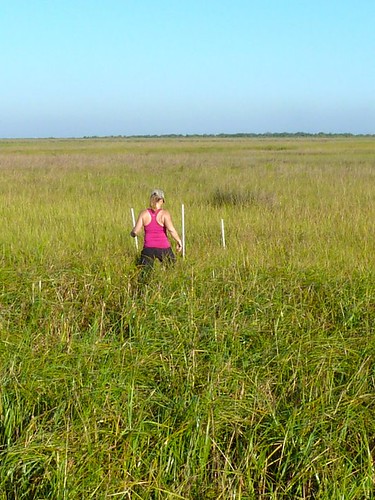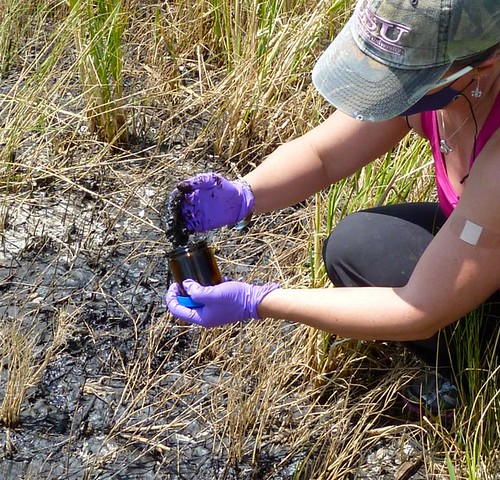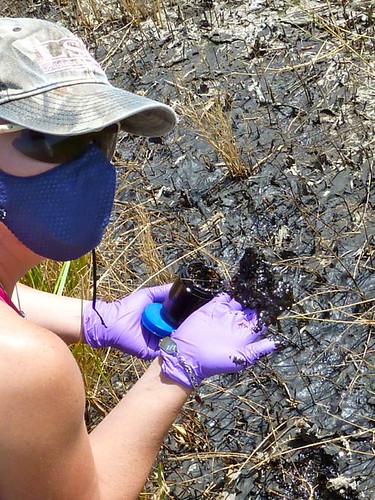Disaster in the Gulf; So What are We Doing About It?
In the Gulf, new information is confirming fears that fish and wildlife—and millions of people on the Coast—are being seriously impacted by the 4.9 million barrels of BP oil spewed from the ocean deep last year.
A new report from the Waterkeeper Alliance shows the BP disaster is still unfolding. The report points to ongoing public health problems, long-term damages to the environment, and a growing need for environmental monitoring and restoration programs to fight decades of petroleum industry assaults and the growing impacts of climate change.
According to the Waterkeeper State of the Gulf report, the effects are just beginning:
The oil is not gone, and long-term impacts are still unknown. If past oil spills are used as a barometer we can fully expect the Gulf Coast to suffer continued environmental degradation for decades. Leading scientific studies are showing that three fourths of the oil is still lingering on the bottom of the Gulf of Mexico, creating an unprecedented and unknown new environmental reality for the Gulf Coast. Oil is also still along the coastal areas in the form of tar balls, strings, and mats as well as in subsurface sandy beach areas. Our governmental and community leaders must work in concert to find long-term, sustainable solutions for recovery and restoration.
Although federal and state authorities continue to insist all is well with Gulf seafood, questions persist, especially among fishermen who are finding abnormalities in their catches. Experts also question whether FDA is adequately testing seafood and looking for certain toxic chemicals that are associated with crude. The Waterkeeper Alliance also has been sampling seafood in the Gulf and its findings have raised alarms in some circles that hazardous compounds are entering the seafood chain in increasing amounts;
We found petroleum hydrocarbon contamination in all of the areas that were sampled and in the tissue of many of the seafood species. The data that we collected also lead us to believe that Polycyclic Aromatic Hydrocarbon (PAH) contamination in some seafood species may be increasing over time.



LSU scientist Linda Hooper-Bui samples oiled Louisiana marshes in September.
Photos: Mac MacKenzie
Meanwhile, health problems continue to plague many residents of the Gulf, people from all walks of life—from fishermen and oil clean-up workers to beach lovers and surfers—who say they continue to suffer ailments from exposure to oil and chemical dispersants. Here's how the State of the Gulf report explains it:
While setting up pathways toward ecosystem restoration, the government continues to ignore citizens’ calls for action on public health. Currently there is no government forum for those suffering from and concerned about the short- and long-term health impacts. The impacts extend along the entire Gulf of Mexico states and consist of current and ex oil cleanup workers and coastal communities. The people of the Gulf Coast are still in need of proper diagnosis, treatment, and medical monitoring.
Scientists are finding disturbing evidence that the fragile Gulf ecosystem has been delt a a serious blow by the millions of gallons of oil that leeched into fertile wildlife breeding grounds and wetland areas critical to coastal fisheries. As Times-Picayune outdoors writer Bob Marshall reported recently, scientists are concerned that low levels of toxic compounds could be damaging fish species like the marsh-dwelling killifish, a key species of the gulf ecosystem;
“I wasn’t surprised we detected responses to an animal that is at high risk to exposure; what surprised me was the responses came at such low levels of the hydrocarbons,” said Andrew Whitehead, lead author of the study, which was published in Proceedings of the National Academies of Science.
“We were detecting cellular responses to toxins that are predictive of impairment of reproduction and embryo development, and we also detected that gills were compromised. We are seeing early warning indicators that would precede any population-level long-term effects.”
Some scientists go even further, concerned that problems they’re finding in fish and wildlife may also be showing up in humans. Here’s what Patricia Williams of the Ponchetrain Institute for Environmental Sciences told WVUE-TV in New Orleans:
“We're talking about a diverse group of chemicals, polcyclic aromatic hydrocarbons, that interact with each other,” said Dr. Patricia Williams. “They are powerful carcinogens and powerful reproductive toxins….I've interviewed tar ball workers and what we're finding is that any problem we're seeing in wildlife, we're seeing in humans, with reproductive and neurological problems.”
Meanwhile news from the fisherman community continues to be grim, especially from shrimpers hoping to rebound from the oil blowout last year. That’s not happening apparently. Louisiana Shrimp Association President Clint Guidry told WWLTV in Baton Rouge that crucial white shrimp catches are down 80 percent this year. He said most fishermen blame it on the oil:
"I think you will find the parishes that were most affected by oil are down (in terms of shrimp)," Guidry said. "We are just seeing something (a lower number of shrimp), and what we see on the beaches is a minute fraction of what went on in the Gulf. I don't think we will ever know what it (the oil) killed."
But for the long term health of the Gulf and its people, the most important solution to saving the Gulf—where coastal erosion represents 80 percent of the nation’s total land loss—is to put most of the money from BP penalties into restoration projects. A new report from the presidentially-appointed Gulf Coast Ecosystem Restoration Task Force lays out the goals for restoring the severely damaged coast, a Herculean task in a region with a myriad of special interests vying for support.
"One of the results of all the meetings is a real sense of urgency," EPA chief Lisa Jackson told The AP. "Person after person came in and said 'we're losing the Gulf.' None of it is irreversible, but the longer we wait, the harder it will be."
But Congress has yet to act on it. New legislation to direct billions of dollars of future BP Clean Water Act fines to Gulf restoration efforts is still mired in Congress. And lawmakers have yet to pass laws to strengthen oil spill legislation, as my NRDC colleague Regan Nelson blogged recently.
Still, the fact that the health of the Gulf is finally receiving any attention at all is a welcome change for those who complain bitterly that the region is a sacrifice zone for the petrochemical industry. Perhaps it took the largest oil spill in history to wake people up to the fact that the Gulf—while resilient—is not invincible to constant man-made assaults.
So the question remains, will we use this oil disaster as an opportunity to heal and protect one of the natural treasures of the world? Or will we squander it and conduct business as usual?
For those who want the Gulf to survive, the latter is not an option.
